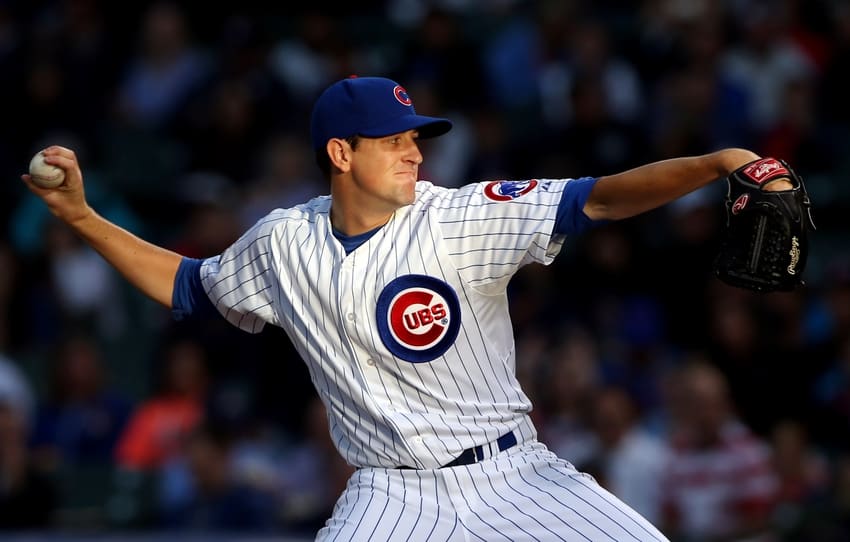
Improved Pitch Count Efficiency Could Take Kyle Hendricks from Good to Great
Before I get into this good-to-great story, I admit no bigger fan of Kyle Hendricks exists than me. When the Chicago Cubs traded Ryan Dempster to Texas in 2011, most considered third-baseman Christian Villanueva the prospect to watch. However, it was Hendricks and his minor league stats that more astonished me and caused me to watch and root.
In the years since, such fun watching his many command-blind critics eat crow. Having admitted their mistake, many have now even swung wildly in the opposite direction, calling Hendricks an ace and expecting a Cy Young at some point. However, as much as the fan in me wishes otherwise, I must say their wild superior praise seems as thinly based as those old knocks.
That’s because Hendricks’ development seems to have stagnated just short of vaunted 200-plus-inning ace territory. Now, if this is where Hendricks plateaus, it’s still a very good place. But titles are won normally with at least one shut-down ace, and this year’s Cubs rotation – heavy on No. 2’s – currently welcomes all applications.
The biggest hurdle preventing Hendricks from breaking through as this kind of ace? His pitch-count efficiency, which has gotten incrementally worse each year. This means his ability to consistently go deep in games is paradoxically declining as he reaches his peak years. Consider these stats:

Casually effective
Some probably are saying, “Huh? Didn’t you see those seven stellar shutout innings thrown last Thursday against the Brewers?” Yes, I did. In fact, that start provides a great exhibit A.
Thursday was easily Hendricks’ best game this year. He walked none, surrendered four hits, induced lots of weak contact and faced just three batters over the minimum. Even so, he needed 94 pitches to go seven innings, or just under four pitches per batter faced.
As Hendricks approaches 2,500 major league batters faced and 10,000 major league pitches thrown, you’d actually expect the opposite trend. But since his command and stuff remain the same, tactical in-game adjustments are clearly needed.
So why have his pitches/batter faced numbers deteriorated?
The answer is two-fold. One, the league established its book on him at least since the start of last year. Hitters seldom swing at first pitches, and most know when Hendricks gets ahead mid-count, he prefers to nibble and waste pitches outside the zone to set up his change.
So the scouts say to just wait him out and take your chances with a 2-2 or 3-2 count. And since your chances for hard contact against him are just as good late in counts as early, it makes sense to run up his pitch count and get to the bullpen sooner.
This was largely the case Thursday. Only five of 24 Brewers hitters swung at the first pitch, and three of those came in Hendricks’ last inning when at his most fatigued. Plus, despite allowing just four baserunners, only 60 percent of his pitches were strikes (57 strikes versus 37 balls).
The second reason is that when Hendricks does waste pitches, he often wastes them way out of the zone. In Thursday’s game, 20 of his 37 called balls were six inches or more outside. These aren’t “nibblers,” and none were swung at.
It’s like Hendricks is saying, “If I’m going to waste this pitch, I’m going to make sure it doesn’t accidentally drift back into the zone.” But this makes them literal wasted pitches that pointlessly run up his pitch count.
Consequently, to make his next big leap forward, Hendricks must improve pitch efficiency and go deeper in games. This can be done in two ways. As noted above, don’t waste so many pitches so wildly out of zone. Yes, easier said than done, but for a command pitcher like Hendricks, one would expect a more tightly clumped pitch chart than the one we see above.
Next, he must become less predictable mid-count. Five or six times a game on 0-2 and 1-2 counts, instead of nibbling, bust the hitter inside but still in the zone.
He did this twice against the Brewers, which is not near enough. In the 4th inning against Ryan Braun, Hendricks went up 1-2 on a fouled-off fastball. He then followed up with an inside change for a swinging strikeout. The next inning, he went up 1-2 on a change-up to Jonathan Villar and followed this with another change-up in the zone for the out.
We must credit Hendricks’ strong command and stuff for remaining such a quality No. 2 pitcher without varying from scouting reports, but Cubs coaches stress embracing the uncomfortable. For Hendricks, I recommend fully bear-hugging that awkwardness by challenging more hitters mid-count and wasting fewer pitches.
In this way, he could really take that next step from very good to great and emerge as that consensus workhorse ace many of us have been predicting.
